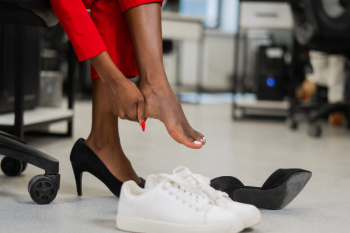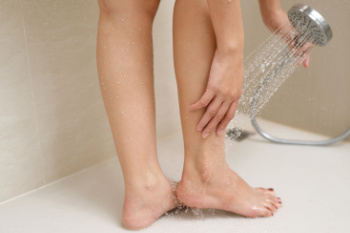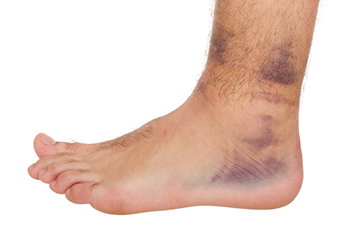Middlefield (860) 349-8500
Wallingford (203) 294-4977
Middlefield (860) 349-8500
Wallingford (203) 294-4977

The plantar fascia is a long, thick band of tissue that spans from the heel bone along the bottom of the foot to the toes. The plantar fascia supports the bottom of the feet and toes during walking, running, and jumping. It can become overly stressed, or even tear or rupture, from overuse or injury that causes pain and inflammation, termed plantar fasciitis. Being obese, standing or working on your feet for prolonged periods of time, or having flat feet or high arches can all contribute to this condition. Engaging in activities that involve dancing, marching, or running can also add to, or possibly worsen, the symptoms of plantar fasciitis. Certain footwear, such as high heels, flip flops, worn out shoes, or other types of footwear with inadequate support, can also increase the risk of developing this condition. A podiatrist will use a variety of ways to treat plantar fasciitis depending upon the severity of the condition and how long the patient has been suffering from it. If you have been dealing with pain from plantar fasciitis, it is suggested you schedule an appointment with a podiatrist for a diagnosis and comprehensive treatment plan.
Plantar fasciitis is a common foot condition that is often caused by a strain injury. If you are experiencing heel pain or symptoms of plantar fasciitis, contact Dr. Gordon Fosdick from Affiliated Foot Care Center. Our doctor can provide the care you need to keep you pain-free and on your feet.
What Is Plantar Fasciitis?
Plantar fasciitis is one of the most common causes of heel pain. The plantar fascia is a ligament that connects your heel to the front of your foot. When this ligament becomes inflamed, plantar fasciitis is the result. If you have plantar fasciitis you will have a stabbing pain that usually occurs with your first steps in the morning. As the day progresses and you walk around more, this pain will start to disappear, but it will return after long periods of standing or sitting.
What Causes Plantar Fasciitis?
There are some risk factors that may make you more likely to develop plantar fasciitis compared to others. The condition most commonly affects adults between the ages of 40 and 60. It also tends to affect people who are obese because the extra pounds result in extra stress being placed on the plantar fascia.
Prevention
There are a variety of treatment options available for plantar fasciitis along with the pain that accompanies it. Additionally, physical therapy is a very important component in the treatment process. It is important that you meet with your podiatrist to determine which treatment option is best for you.
If you have any questions, please feel free to contact our offices located in Middlefield and Wallingford, CT . We offer the newest diagnostic and treatment technologies for all your foot care needs.

Football players frequently suffer from foot and ankle injuries due to the sport's high-impact and dynamic nature. Common injuries can include ankle sprains, fractures, Achilles tendonitis, and turf toe. These injuries often occur from sudden changes in direction, collisions, and overuse during intense play. Ankle sprains happen when ligaments are stretched or torn, usually from a twisting motion. Fractures can result from direct impacts or severe twists, while Achilles tendonitis stems from repetitive strain on the tendon. Turf toe, a sprain of the big toe joint, is caused by pushing off repeatedly on hard surfaces. Preventive measures include proper warm-ups, strength training, and wearing appropriate footwear with good ankle support. Relief involves rest, compression, and elevation. If you play football and have sustained a foot or ankle injury, it is suggested that you schedule an appointment with a podiatrist for a proper diagnosis, treatment, and rehabilitation, ensuring a safe return to play.
Sports related foot and ankle injuries require proper treatment before players can go back to their regular routines. For more information, contact Dr. Gordon Fosdick of Affiliated Foot Care Center. Our doctor can provide the care you need to keep you pain-free and on your feet.
Sports Related Foot and Ankle Injuries
Foot and ankle injuries are a common occurrence when it comes to athletes of any sport. While many athletes dismiss the initial aches and pains, the truth is that ignoring potential foot and ankle injuries can lead to serious problems. As athletes continue to place pressure and strain the area further, a mild injury can turn into something as serious as a rupture and may lead to a permanent disability. There are many factors that contribute to sports related foot and ankle injuries, which include failure to warm up properly, not providing support or wearing bad footwear. Common injuries and conditions athletes face, including:
Sports related injuries are commonly treated using the RICE method. This includes rest, applying ice to the injured area, compression and elevating the ankle. More serious sprains and injuries may require surgery, which could include arthroscopic and reconstructive surgery. Rehabilitation and therapy may also be required in order to get any recovering athlete to become fully functional again. Any unusual aches and pains an athlete sustains must be evaluated by a licensed, reputable medical professional.
If you have any questions please feel free to contact our offices located in Middlefield and Wallingford, CT . We offer the newest diagnostic and treatment technologies for all your foot and ankle needs.

Maintaining a daily foot care routine is vital for overall foot health and comfort. Begin by washing your feet with mild soap and warm water to remove dirt and prevent infections. Be sure to dry them thoroughly, especially between the toes, to avoid fungal issues. Regularly stretching your feet and ankles can enhance flexibility and reduce the risk of injuries. Incorporate simple stretches like toe raises and ankle circles into your daily routine. Trimming toenails properly is also essential. Cut them straight across to prevent ingrown toenails and avoid cutting too short, which can lead to discomfort. If you have developed any type of foot pain, it is suggested that you consult a podiatrist who can offer treatment remedies and guide you on how to care for your feet daily.
Everyday foot care is very important to prevent infection and other foot ailments. If you need your feet checked, contact Dr. Gordon Fosdick from Affiliated Foot Care Center. Our doctor can provide the care you need to keep you pain-free and on your feet.
Everyday Foot Care
Often, people take care of their bodies, face and hair more so than they do for their feet. But the feet are a very important aspect of our bodies, and one that we should pay more attention to. Without our feet, we would not be able to perform most daily tasks.
It is best to check your feet regularly to make sure there are no new bruises or cuts that you may not have noticed before. For dry feet, moisturizer can easily be a remedy and can be applied as often as necessary to the affected areas. Wearing shoes that fit well can also help you maintain good foot health, as well as making it easier to walk and do daily activities without the stress or pain of ill-fitting shoes, high heels, or even flip flops. Wearing clean socks with closed shoes is important to ensure that sweat and bacteria do not accumulate within the shoe. Clean socks help to prevent Athlete’s foot, fungi problems, bad odors, and can absorb sweat.
If you have any questions please feel free to contact our offices located in Middlefield and Wallingford, CT . We offer the newest diagnostic and treatment technologies for all your foot and ankle needs.

The bones in the ankle are connected by a variety of ligaments. Ankle sprains occur when these ligaments either become overstretched or torn, usually because the ankle is twisted. Mild ankle sprains usually just mean that the ankle is tender and swollen, but more severe ankle sprains can make the ankle unstable and unable to support any weight. A podiatrist can examine your ankle and determine whether it is sprained. Because the symptoms of an ankle sprain are often like that of a broken ankle, an X-ray or other imaging test may be necessary. Upon the diagnosis of an ankle sprain, or fracture, a podiatrist will be able to provide a treatment plan for the injury. Recurring or severe sprains can cause long-term weakness and joint pain if not properly treated. If you suspect you may have sprained an ankle, it is suggested that you make an appointment with a podiatrist.
Although ankle sprains are common, they aren’t always minor injuries. If you need your ankle injury looked at, contact Dr. Gordon Fosdick from Affiliated Foot Care Center. Our doctor can provide the care you need to keep you pain-free and on your feet.
How Does an Ankle Sprain Occur?
Ankle sprains are the result of a tear in the ligaments within the ankle. These injuries may happen when you make a rapid shifting movement while your foot is planted. A less common way to sprain your ankle is when your ankle rolls inward while your foot turns outward.
What Are the Symptoms?
Preventing a Sprain
Treatment of a Sprain
In many cases, the RICE method (Rest, Ice, Compression, and Elevate) is used to treat ankle sprains. However, you should see a podiatrist to see which treatment option would work best with your injury. In severe cases, surgery may be required.
It is important to ask your doctor about rehab options after you receive treatment for your injury. Stretching, strength training, and balance exercises may help the ankle heal while also preventing further injury.
If you have any questions, please feel free to contact our offices located in Middlefield and Wallingford, CT . We offer the newest diagnostic and treatment technologies for all your foot care needs.